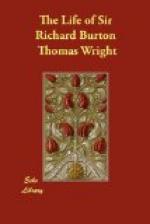[FN#120] How this tradition arose nobody seems to know. There are several theories.
[FN#121] It is decorated to resemble a garden. There are many references to it in the Arabian Nights. Thus the tale of Otbah and Rayya (Lib. Ed., v., 289) begins “One night as I sat in the garden between the tomb and the pulpit.”
[FN#122] Pilgrimage to Meccah (Mem. Ed., i., 418).
[FN#123] Mohammed’s son-in-law.
[FN#124] Mohammed’s wet nurse.
[FN#125] Son of Mohammed and the Coptic girl Mariyah, sent to Mohammed as a present by Jarih, the Governor of Alexandria.
[FN#126] Khadijah, the first wife, lies at Mecca.
[FN#127] Known to us chiefly through Dr. Carlyle’s poor translation. See Pilgrimage, ii., 147.
[FN#128] Here am I.
[FN#129] Readers of The Arabian Nights will remember the incident in the Story of the Sweep and the Noble Lady. “A man laid hold of the covering of the Kaaba, and cried out from the bottom of his heart, saying, I beseech thee, O Allah, etc.”
[FN#130] See Genesis xxi., 15.
[FN#131] The stone upon which Abraham stood when he built the Kaaba. Formerly it adjoined the Kaaba. It is often alluded to in The Arabian Nights. The young man in The Mock Caliph says, “This is the Place and thou art Ibrahim.”
[FN#132] See also The Arabian Nights, The Loves of Al-Hayfa and Yusuf, Burton’s A.N. (Supplemental), vol. v.; Lib. Ed., vol. xi., p. 289.
[FN#133] Burton’s A.N., v., 294; Lib. Ed., iv., 242.
[FN#134] See Chapter ix.
[FN#135] Sporting Truth.
[FN#136] The reader may believe as much of this story as he likes.
[FN#137] The man was said to have been killed in cold blood simply to silence a wagging tongue.
[FN#138] See Shakespeare’s King John, act i., scene i.
[FN#139] Burton’s translation of the Lusiads, vol. ii., p. 425.
[FN#140] Although Burton began El Islam about 1853, he worked at it years after. Portions of it certainly remind one of Renan’s Life of Jesus, which appeared in 1863.
[FN#141] To some of the beauties of The Arabian Nights we shall draw attention in Chapter 27.
[FN#142] Of course both Payne and Burton subsequently translated the whole.
[FN#143] First Footsteps in East Africa. (The Harar Book.) Memorial Ed., p. 26.
[FN#144] Esther, vi., 1.
[FN#145] Boulac is the port of Cairo. See Chapter xi..
[FN#146] Zeyn al Asnam, Codadad, Aladdin, Baba Abdalla, Sidi Nouman, Cogia Hassan Alhabbal, Ali-Baba, Ali Cogia, Prince Ahmed and the Fairy Peri-Banou, The two Sisters who were jealous of their Cadette.
[FN#147] Edward William Lane (1801-1876). He is also remembered on account of his Arabic Lexicon. Five volumes appeared in 1863-74, the remainder by his grand-nephew Stanley Lane-Poole, in 1876-1890.




